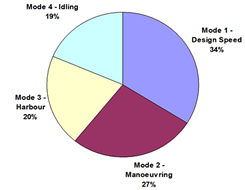
The baseline vessel is a Ro-Pax Ferry which is able to carry up to 700 passengers and 143 cars or 20 commercial trailers. It has an overall length of 117.9m, is 19.2m wide and has a deadweight of about 1500tdw. The service speed is 19,2kn and it will operate in near coastal area with harsh weather conditions.
The vessel has a distinct operating profile with service speed, maneuvering, harbor time and an idle condition overnight. The distribution is shown in the following pie chart.
The vessel has a conventional diesel mechanic engine installation. For redundancy purposes a power take in will guarantee that the operating profile can be matched with one of the two main engines out of order. Three auxiliary diesel engines in total are installed to produce the electrical power needed.
2025 Ship Concept
The 2025 design is supposed to be the first step to an even more efficient and environmental friendly future. The objectives for reduction of CO2-emissions for the 2025 design (20% compared to baseline vessel) shall be achieved through efficiency enhancement by including waste heat recovery technologies for exhaust gas and cooling water system. Other energy efficiency enhancement like frequency controlled sea cooling water pumps and ventilation as well as further engine optimization (e. g. two stage turbo charging system) will be considered. In order to build up a high efficient system configuration the system compatibility of all implemented technologies will be checked by an energy grid simulation in order to be able to prove the overall efficiency enhancement.
Beside reduction of CO2-emissions, the ECA-standard for sulfur reduction and Tier III compliance shall be ensured for this 2025 design. The possible trade off for compliance with these ECA-regulations by applying “end of the pipe technology” like a wet scrubber system and/or SCR (Selective Catalytic Reactor) and the need for reduction of CO2-emissions will be investigated in detail.
According to first approximations we may expect a reduction of CO2-emissions of about 10 % from the efficiency enhancements. This is half of the requested reduction and the basic idea is to realize the remaining 10% of the total reduction by the use of alternative drop-in fuels. We will investigate two options in this respect, namely the production of liquid fuel from 2nd generation bio-mass (also called BtL-Diesel) or the conversation of carbon sources from industrial processes (or even segregation from atmosphere) to liquid fuel using the Fischer-Tropsch Synthesis.
But since first findings revealed that due to the high amount of energy that is necessary to produce these fuels and the availability of feedstock from bio-mass for the shipping industry may be critical to be secured, we might also need to investigate the possibility to operate the vessel ship with LNG or even methanol.
2050 Ship Concept
The objective for the reduction of CO2- emission for the 2050 design is 80% for the Ro-Pax Ferry. This will require a complete different energy production and propulsion system. Therefore a full electric ship is considered driven by an electric propulsion motor which is fed either by a fuel cell or a red-ox flow battery.
Each technology has its own challenge, the fuel cell has space and safety problems, while the red-ox flow battery will introduce weight problems into the ship design.
For the fuel cell hydrogen as a fuel is preferred in the first instance. Though hydrogen has a high energy density related to its weight, its volumetric energy density is relatively low. In addition hydrogen is highly explosive. But we are sure in 2050 these problems can be solved.
The red-ox flow battery has a pretty bad capacity-weight ratio and with this technology weight problems are expected. However, future improvements to increase the energy density can be expected and much of the existing engine equipment is no longer necessary. A proper balance of the future weight distribution may thus allow us to install such a new concept.
These two systems will be compared and it will be checked whether the developed simulation environment is useful for the task to compare the new technologies according to their overall efficiency including weight, space and financial aspects as well.
Energy from renewable sources like wind and wave power plants shall be used as primary energy source. Thus an infrastructure to support the vessel with energy locally generated from such renewable sources is needed. In case of the red-ox flow battery some harbours on the ferry’s route would have to be equipped with a terminal to exchange the fluids and load them again. For the fuel cell the hydrogen infrastructure has to be ensured.


